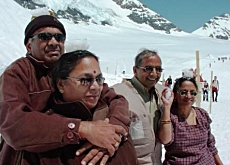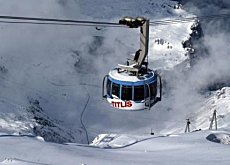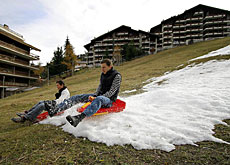Ski region counts the cost of climate change

One of Switzerland's best-known ski regions, the Bernese Oberland, has become the first to tally up the cost of climate change to the tourist industry.
According to a report released on Monday, the impact on the region, which includes resorts such as Interlaken and Gstaad, will be destructive but not devastating.
By the year 2030, winter revenues will drop by around 30 per cent, and more than one-third of the region’s ski areas will cease to exist.
The good news for a region highly dependent on tourism is that warmer weather will lead to an increase in visitor numbers in summer, making up for a large chunk of the shortfall.
The report commissioned by the nine official destinations in the Bernese Oberland was carried out by Bern University’s Research Institute for Leisure and Tourism.
It is based on climate models forecasting a maximum rise in temperature of 1.8 degrees Celsius in winter and 2.6°C in summer over the next two decades. They include a significant increase in precipitation – rain below/snow above 1,500m – in winter and large drop in summer.
The report highlights the variety of problems faced by the industry, mainly the investments required to adapt tourism to climate change, and to ensure that skiing will still be possible even if only at a few large resorts blessed with high-altitude ski runs.
The money would go to build ski lifts at higher altitudes and to increase artificial snowmaking capabilities. It would also have to help secure ever diminishing supplies of water needed to make the snow and measures to protect local populations and tourists from a predicted rise in natural disasters such as avalanches and rockslides.
“The destinations want to know exactly what’s happening in their region and how they can prepare themselves,” main author of the study, Professor Hansruedi Müller, told swissinfo.
Awareness
“This shows that they are aware of the situation and must be prepared for a different climate, but they also see that the new situation presents opportunities. For example, last July, which was very hot, was very profitable for the lift companies in the higher regions.
“It’s a chance for the rebirth of summer tourism as people want fresh, cool air.”
“[This study puts] us ahead. It’s important that the industry – mountain lifts and hotels – acts now and takes into account a potential rise in temperature when making investments,” Casimir Platzer, Kandersteg hotel owner, and president of the region’s hotel association, told swissinfo.
“I think we are acting [already] by taking appropriate measures, and not reacting,” Platzer said, arguing that mountain resorts had to move away from their dependence on skiing and diversify, one of the report’s main recommendations.
Water problem
“The biggest problem for all destinations will be water [for snow making],” acknowledged Christoph Egger, president of canton Bern’s association of ski and mountain lifts, and a member of the management board of the Jungfrau Railways. It owns and operates most of the railways and ski lifts around Interlaken, Grindelwald and Wengen.
“The Jungfrau Railways will invest SFr5 million ($4.09 million) over the next two years in water. That’s about one-third of the total investments made by the company in its infrastructure,” Egger told swissinfo.
Felix Hari, the mayor of the village of Adelboden, said the main threat to the medium-sized resort was not a lack of snow or water but avalanches and rockslides which had the potential to block the one access road to the resort.
But his veiled appeal for taxpayers to foot the bill to secure the road was met with scepticism by politicians in attendance.
“Regions like the Bernese Oberland cannot on the one hand call on the cantonal government to reduce its budget deficit and on the other demand the building of new roads,” said Hans Bieri, a Social Democratic member of the cantonal parliament.
But Bieri said the state would eventually have to intervene to ensure the survival of small communities in the alpine valleys forced to close their ski lifts and which do not have the resources to diversify their modest tourist sector.
swissinfo, Dale Bechtel in Thun
By the year 2030, there will be a 35% drop in the number of skiers in winter, and 25% fewer hotel bookings.
This will lead to a decrease in winter turnover of SFr200 million.
Summer will see a 10% rise in the number of visitors, and 5% increase in hotel bookings, leading to SFr80 million more income.
Minimum scenario by 2030:
Winter: 0.4ºC rise
Summer: 0.6ºC rise
“Snowline” will rise in altitude by 50-60m
A small increase in precipitation in winter, and minor decrease in summer
Slight increase in thawing of permafrost
Glacial retreat will continue at present rate
Maximum scenario by 2030:
Winter: 1.8ºC rise
Summer 2.6ºC rise
“Snowline” will rise in altitude by 250-270m
Precipitation to increase in winter by 11%
Precipitation to decrease in summer by 18%
Glacial retreat will speed up considerably
Thawing permafrost will cause increase in rockslides
Generally, more natural disasters expected

In compliance with the JTI standards
More: SWI swissinfo.ch certified by the Journalism Trust Initiative













You can find an overview of ongoing debates with our journalists here . Please join us!
If you want to start a conversation about a topic raised in this article or want to report factual errors, email us at english@swissinfo.ch.